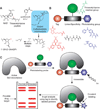Mechanisms and molecular probes of sirtuins
- PMID: 18940661
- PMCID: PMC2626554
- DOI: 10.1016/j.chembiol.2008.09.009
Mechanisms and molecular probes of sirtuins
Abstract
Sirtuins are critical regulators of many cellular processes, including insulin secretion, the cell cycle, and apoptosis. Sirtuins are associated with a variety of age-associated diseases such as type II diabetes, obesity, and Alzheimer's disease. A thorough understanding of sirtuin chemical mechanisms will aid toward developing novel therapeutics that regulate metabolic disorders and combat associated diseases. In this review, we discuss the unique deacetylase mechanism of sirtuins and how this information might be employed to develop inhibitors and other molecular probes for therapeutic and basic research applications. We also cover physiological regulation of sirtuin activity and how these modes of regulation may be exploited to manipulate sirtuin activity in live cells. Development of molecular probes and drugs that specifically target sirtuins will further understanding of sirtuin biology and potentially afford new treatments of several human diseases.
Figures



References
-
- Ahuja N, Schwer B, Carobbio S, Waltregny D, North BJ, Castronovo V, Maechler P, Verdin E. Regulation of insulin secretion by SIRT4, a mitochondrial ADP-ribosyltransferase. J Biol Chem. 2007;282:33583–33592. - PubMed
-
- Avalos JL, Boeke JD, Wolberger C. Structural basis for the mechanism and regulation of Sir2 enzymes. Mol Cell. 2004;13:639–648. - PubMed
-
- Bae NS, Swanson MJ, Vassilev A, Howard BH. Human histone deacetylase SIRT2 interacts with the homeobox transcription factor HOXA10. J Biochem (Tokyo) 2004;135:695–700. - PubMed
Publication types
MeSH terms
Substances
Grants and funding
LinkOut - more resources
Full Text Sources
Other Literature Sources

